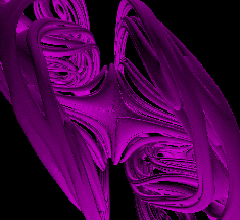Quaternion Julia Sets in Virtual Reality
January 15th, 1993 - December 15th, 1995
Categories: Applications, VR Art

About
A Julia Set is the map of the behavior of an equation when its output is fed back into its input (recursive). The equation mapped is z = z2 + k. In general, the most common Julia Set is a map of that equation in complex numbers (2D numbers).
In this case, the researchers are mapping the equation in quaternions, which are 4D hyper-complex numbers. They are investigating a method for visualizing Julia Sets based on estimating the distance from the viewpoint to the surface of the Julia Set. A distance estimation technique has been mathematically proven to be correct for complex 2D numbers; they are experimenting with an analog to the estimation equation for 4D quaternions.
This experimental work demands both new theoretical work and a finer grained approach to the experimentation. On the theoretical side, collaborator Yumei Dang is pursuing a program to analyze the distance estimate using theorems in analysis over the quaternions. To complement this, she is pursuing the best ways to push the distance estimate algorithm and corresponding rendering processes on good computer systems. Because these images are time consuming to create, this limits the flexibility of the experiments. Greater flexibility is the main mathematical reason for wanting the best supercomputer help for this problem. It is to be expected that a good and flexible source of images for higher-dimensional Julia and Mandelbrot Sets will raise many mathematical questions heretofore unknown.
“Quaternion Julia Sets in Virtual Reality” premiered at Supercomputing ’95. Participants could interactively change the constants specifying the Quaternion Julia Set, evolving one fractal form from another, viewing the results in the CAVE™ Virtual Reality Theater.
Computation and rendering of these mathematical forms was done across three supercomputers. Successive refinement techniques were incorporated to address display and performance issues.